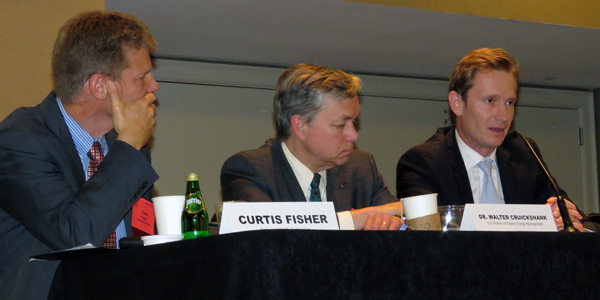By Rich Heidorn Jr.
WASHINGTON — Even as the Trump administration has rejected the Paris Agreement and works to boost coal-fired generation, optimism has been building on the East Coast for the offshore wind industry.
The U.S. market has gained momentum in the last two years, the head of DONG Energy Wind Power U.S. told the Energy Bar Association’s Mid-Year Energy Forum during a panel discussion last week.

President Thomas Brostrøm credited state renewable portfolio standards and carbon reduction goals for creating demand. And he said the shallow waters off the East Coast provide attractive sites like those in Europe.
DONG, the No. 1 offshore wind generator in the world, clearly sees renewables as the future. On Oct. 30, it will ask shareholders to approve changing its name — originally an abbreviation for Danish Oil and Natural Gas — to reflect its commitment to renewable power. It completed the divestiture of its upstream oil and gas business in September. The new name, Ørsted, honors Danish scientist Hans Christian Ørsted, who is credited with discovering electromagnetism in 1820.
The company, which operates more than 1,000 offshore wind turbines in Europe, acquired the rights to develop more than 1,000 MW off New Jersey and is working on a pilot project with Dominion Energy off Virginia. (See Dominion Plans 12-MW Offshore Wind Project, 2nd in US.) It also has formed a joint venture with Eversource Energy to bid on Massachusetts’ solicitation for 1,600 MW of offshore wind.

Brostrøm said the industry has matured over the last two decades as it has moved from “bespoke” projects to more standardization. At the same time, the technology has advanced from 3.6-MW turbines in 2009 to 8-MW turbines today, with next-generation models expected at 12 to 15 MW.

The panel discussion, moderated by Holland & Knight partner Mark C. Kalpin, also included Walter Cruickshank, acting director of the U.S. Bureau of Ocean Energy Management, and Curtis Fisher, executive director of the National Wildlife Federation’s Northeast Region.

Since 2009, BOEM has issued 13 offshore commercial wind energy leases, giving leaseholders the right to seek approval for development plans. The U.S. currently has only one operating offshore wind project, Deepwater Wind’s 30-MW Block Island Wind Farm in state waters off Rhode Island, which went into service last December.
“We have quite a bit to learn, still, about how things will operate — how developers will move forward with their projects,” Cruickshank said.
On Aug. 31, Interior Secretary Ryan Zinke, Cruickshank’s boss, signed an order setting a one-year target for completing environmental reviews under the National Energy Policy Act following the issuance of a Notice of Intent. “We haven’t entirely figured out how we’re going to do that yet, but we are working on trying to improve our processes,” Cruickshank said.
Fisher said his organization supports offshore wind when it is sited “in the right places” and construction minimizes impacts on aquatic life. The group is especially concerned that foundations are not drilled during the migration of endangered North Atlantic right whales because the noise can disturb the marine mammals. Fewer than 500 are believed alive.
“This is our big chance” to address climate change, Fisher said. “I fundamentally believe that this is the challenge of our generation — to actually build [renewable] projects on scale to solve problems that many people think are just too big to solve.”



